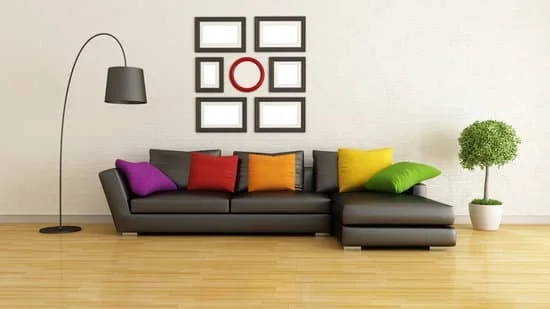In the pursuit of creating a beautiful and inviting home, it is essential to recognize the importance of compromise. From choosing color schemes to selecting furniture styles, couples or individuals with different decor preferences often find themselves at odds when it comes to making decisions. However, finding a middle ground can lead not only to a visually pleasing environment but also to peace and harmony within the home.
Believe it or not, compromising on home decor choices offers numerous benefits. It fosters open communication, deepens understanding between individuals, and cultivates an atmosphere of cooperation. By respecting each other’s ideas and perspectives during the decision-making process, compromises are born that reflect a shared vision for the home.
But how exactly do we reach these compromises? It starts by identifying our individual decor preferences and clearly articulating them. By reflecting on our personal style and understanding what truly speaks to us, we set the foundation for effective communication with our partners or housemates. Through open dialogue, we can explore possibilities and seek common ground that aligns diverse tastes into one cohesive look.
Remember, compromise in home decor is not about sacrificing your own desires or giving up what you love most. It is about finding solutions that satisfy both parties involved while achieving a harmonious balance within your living space.
Throughout this article, we will delve into various strategies for overcoming differences when it comes to color schemes, design aesthetics, furniture arrangements, decorative accessories, and more. Join us on this journey as we uncover practical techniques and creative ideas that will enable you to compromise graciously without compromising on style or personal expression.
Identifying Individual Home Decor Preferences
When it comes to home decor, it is essential to understand and identify individual preferences. Each person has their unique style and taste, which can greatly impact the overall look and feel of a living space. It is important for individuals to reflect on their personal decor preferences in order to effectively communicate and articulate their desired choices.
To begin, take some time to explore your own personal style. Consider what colors, patterns, textures, and design aesthetics resonate with you the most. Think about your favorite pieces of furniture or decorative accessories that you may already have. Reflecting on these preferences will give you a better understanding of your own taste and help you communicate it to others.
Once you have identified your individual decor preferences, it is crucial to effectively communicate them with others who may be involved in making home decor decisions. This can include family members, roommates, or significant others. Be open and honest about what you like and why it resonates with you. Articulating your desires clearly will help create a space where everyone feels their needs are being heard and considered.
In addition to communicating preferences, it is also helpful to listen and be open-minded towards others’ ideas and tastes. Remember that compromise is about finding a middle ground that satisfies everyone involved. Take the time to understand and appreciate different perspectives on home decor. By actively seeking ways to blend various styles together, you can create a harmonious living environment that reflects the collective vision of all individuals in the space.
Identifying individual home decor preferences is an essential step towards achieving compromise in home decor decisions. By reflecting on personal style, communicating effectively, and being open-minded towards others’ ideas, individuals can work together towards creating a living space that satisfies everyone’s desires. Remember that compromise does not mean sacrificing one’s own style entirely but rather finding creative ways to merge different tastes into a cohesive look that brings joy and satisfaction to all residents of the home.
Prioritizing Shared Vision and Goals
In order to successfully compromise on home decor, it is crucial to prioritize a shared vision and goals for the space. When individuals live together, it is important to establish a common ground where both parties feel heard and their preferences are taken into consideration. By aligning individual preferences and creating a cohesive look, a harmonious living space can be achieved.
Establishing Common Goals and Vision
The first step in prioritizing a shared vision and goals for home decor is to have open and honest discussions with all individuals involved. Each person should express their desires, concerns, and expectations for the space. It is important to actively listen to one another’s ideas without dismissing or devaluing them.
During these discussions, it can be helpful to identify common themes or values that everyone agrees upon. This could include elements such as comfort, functionality, or a specific atmosphere that everyone wants the space to evoke. By identifying these shared goals, it becomes easier to find compromise in other aspects of home decor decisions.
Practical Strategies for Alignment
Once common goals and a shared vision have been established, there are practical strategies that can be employed to align individual preferences and create a cohesive look in the home. One effective strategy is to focus on key elements that are important to each person and find ways to incorporate them into the overall design.
For example, if someone wants a minimalist aesthetic while another prefers a more eclectic style, finding furniture pieces that have clean lines but also unique details could be a way to bridge the gap between both preferences. Additionally, exploring color palettes that complement both styles can help tie the different design aesthetics together.
Another helpful strategy is compromising on specific spaces within the home where each individual has more control over the decor choices. For instance, allowing one person complete creative freedom in their personal workspace or hobby room while compromising on other communal areas can help ensure that everyone’s needs are met.
By prioritizing a shared vision and goals, individuals can work together to find compromise in home decor decisions. Through open communication and practical strategies, a harmonious living space that reflects the preferences of all individuals involved can be achieved. Prioritizing shared vision and goals lays the foundation for successful compromise throughout the rest of the home decor process.
Compromising on Color Schemes
Color plays a significant role in home decor as it sets the mood and creates the overall ambiance of a space. When it comes to color choices, individuals often have different preferences and finding a compromise can be challenging. However, by understanding the impact of color on home decor and exploring techniques for finding common ground, creating a harmonious color scheme is achievable.
One technique for compromising on color schemes is to identify colors that both individuals gravitate towards or are drawn to. By finding overlapping preferences, it becomes easier to create a palette that satisfies both parties. For example, if one person prefers warm earthy tones while the other prefers cool blues, shades of green can be an excellent compromise as they blend elements from both warm and cool colors.
Another approach is to explore complementary colors that work well together. Complementary colors are situated opposite each other on the color wheel and create a vibrant contrast when combined. By utilizing complementary colors, each individual’s choice can be represented while still maintaining harmony in the overall color scheme.
Additionally, it’s important to consider the impact of different hues, shades, and tones within a specific color family. For instance, if one person loves bold saturated hues while the other prefers more muted tones, compromising on mid-tones can strike a balance between vibrancy and softness.
| Compromise Technique | Description |
|---|---|
| Finding Overlapping Preferences | Identify colors that both individuals gravitate towards or are drawn to. |
| Utilizing Complementary Colors | Select colors that are situated opposite each other on the color wheel to create an attractive contrast. |
| Considering Hues, Shades, and Tones | Explore different variations within a specific color family to strike a balance between boldness and softness. |
By utilizing these techniques, compromising on color schemes can turn into an opportunity to create unique and visually appealing combinations that reflect the preferences of both individuals. The key is open communication, understanding each other’s aesthetic inclinations, and finding common ground through thoughtful exploration of the vast world of colors.
Balancing Different Design Aesthetics
When it comes to home decor, individuals often have different design aesthetics that they are drawn to. It could be a preference for modern minimalism, a love for traditional elegance, or an affinity for eclectic and bohemian styles. Balancing these different design aesthetics can be a challenge, but with some consideration and creativity, it’s possible to achieve a cohesive look that satisfies both partners’ preferences.
To start, it’s important to understand the characteristics of each design style. Modern minimalism is all about clean lines, simplicity, and functionality. Traditional elegance focuses on ornate details, rich colors, and classic furniture pieces. Eclectic and bohemian styles celebrate individualism and mix various patterns, textures, and cultural influences.
One approach to balancing different design aesthetics is to find elements of each style that can complement each other. For example, in a living room with a modern minimalist sofa, you can incorporate traditional elegance through the use of accessories like decorative pillows with intricate patterns or an elegant coffee table with ornate details. Similarly, mixing eclectic artwork or textiles can add a touch of bohemian charm to any space without overwhelming the overall aesthetic.
Another strategy is to create designated spaces within your home that cater to specific design preferences. This allows each partner to express their style in certain areas while maintaining harmony throughout the rest of the house. For instance, one partner may have their office designed in a modern minimalist style while the other partner’s reading nook showcases a cozy bohemian vibe.
Finding common ground in terms of color palettes is another essential aspect of balancing different design aesthetics. While color choices can greatly impact the mood and atmosphere of a room, there are usually ways to compromise by selecting neutral tones as a base and then incorporating pops of color that reflect both partners’ preferences.
Overall, achieving balance between different design aesthetics requires open communication and willingness to explore new ideas together. By understanding the characteristics of various design styles, looking for complementary elements, and creating designated spaces for individual preferences, it is possible to create a harmonious home that showcases both partners’ tastes.
| Design Aesthetics | Characteristics |
|---|---|
| Modern Minimalism | Clean lines, simplicity, functionality |
| Traditional Elegance | Ornate details, rich colors, classic furniture |
| Eclectic and Bohemian | Mixing patterns/textures, cultural influences |
Negotiating Furniture and Layout
When it comes to home decor, one area that often requires negotiation is furniture selection and layout. People have different preferences when it comes to style, comfort, and functionality, which can often lead to disagreements. However, with effective communication and creative problem-solving, it is possible to find a compromise that satisfies both parties. Here are some tips for navigating conflicting preferences and finding common ground in furniture and layout decisions:
- Identify shared needs: Start by identifying the essential requirements for furniture and layout in your home. Discuss what functions the furniture needs to serve and prioritize comfort and practicality. This will help establish a baseline of shared needs that can guide the decision-making process.
- Explore versatile pieces: Look for furniture options that offer flexibility in terms of style or use. For example, consider choosing a sectional sofa with modular components that can be rearranged to suit different layouts or opting for storage ottomans that double as seating. These versatile pieces can accommodate varying design styles while still meeting functional requirements.
- Create separate zones: If you have conflicting ideas on how to arrange the furniture in a particular room, consider dividing the space into separate zones or areas based on individual preferences. For example, designate one corner as a reading nook with a cozy chair and bookshelf for one person, while another area can be dedicated to entertainment with a TV stand and comfortable seating for the other person.
- Compromise on color and pattern: If disagreement arises over color choices for furniture upholstery or cushions, consider compromising by selecting neutral colors or patterns that can work well with both individuals’ preferences. Alternatively, choose coordinating fabrics that incorporate elements from each person’s preferred color palette.
- Seek balance between styles: In situations where individuals have vastly different design aesthetics, look for ways to blend styles harmoniously. This could involve incorporating eclectic elements such as mixing modern pieces with vintage accents or pairing minimalistic furniture with decorative items that reflect a more traditional style. By finding a balance between different aesthetics, you can create a cohesive look that reflects both personalities.
Remember, compromise is about finding a middle ground that embraces individual tastes while still achieving a harmonious living space. By following these tips and considering each person’s needs and preferences, you can negotiate furniture and layout decisions effectively, creating a home that satisfies everyone involved.
Finding Common Ground in Decorative Accessories
Decorative accessories play a significant role in adding personality and charm to a living space. However, when it comes to home decor, finding common ground on accessorizing can be challenging. Different individuals have their own preferences and tastes when it comes to decorative pieces, making compromise essential. By considering each person’s preferences and exploring different options, it is possible to create a harmonious and balanced look that satisfies everyone involved.
One effective way to compromise on decorative accessories is by creating a shared vision board or inspiration collage. This allows each person to gather images of accessories they love and discuss how they align with the overall aesthetic of the space. By visually analyzing these choices together, it becomes easier to identify overlapping themes or styles that everyone can appreciate.
Another approach is to establish designated areas within the home for showcasing individual preferences. For example, one person could have creative control over the living room while another has more say in the bedroom decor. This way, both individuals have an opportunity to express their personal style without overwhelming the entire space.
Additionally, consider combining decorative accessories from different styles or themes to create a unique blend that reflects both individuals’ tastes. Experimenting with contrasting elements can result in an eclectic yet cohesive look. Incorporating diverse textures, colors, and materials can add depth and visual interest to any room.
Ultimately, compromising on decorative accessories requires open communication, respect for each other’s opinions, and willingness to explore new ideas. By embracing each other’s preferences and finding common ground through thoughtful conversations and creative solutions, it is possible to achieve a well-rounded decor scheme that truly feels like home.
DIY Projects for Compromise
Discovering Shared Interests
When it comes to compromising on home decor, DIY projects can be a fun and creative way to find common ground. By engaging in hands-on activities together, you and your partner or housemate can explore and discover shared interests in home decor. Begin by brainstorming ideas that incorporate elements from both of your personal styles and preferences.
For example, if one person prefers a minimalist aesthetic while the other leans towards a bohemian style, consider creating a DIY wall hanging using simple lines and neutral colors combined with natural fibers and textures. This project allows both aesthetics to coexist harmoniously.
Collaborative Artwork
Another DIY project that promotes compromise is creating collaborative artwork. This activity encourages each person’s creativity while ensuring that both individuals have an equal say in the final design. Start by choosing a theme or subject for the artwork that reflects your shared vision for the space. Whether it’s a landscape painting, abstract piece, or even a collage of photographs, working on artwork together can lead to surprising outcomes that blend both of your unique perspectives.
Furniture Upcycling
If you and your partner or housemate have different preferences when it comes to furniture styles, consider embarking on furniture upcycling projects as a compromise solution. This involves transforming existing furniture pieces into something new that incorporates elements from both design aesthetics.
For instance, if one person favors vintage-inspired pieces while the other prefers modern designs, start by identifying furniture pieces that can be easily refurbished, such as nightstands or coffee tables. Sand down the surface and apply a fresh coat of paint in a color that combines both styles, like retro yellow with sleek black accents.
By engaging in these DIY projects together, not only will you be able to create personalized decor elements but also learn more about each other’s tastes and preferences. The collaborative process of compromise in these projects brings a unique touch to your living space while also fostering a sense of shared accomplishment and pride. Remember, compromising on home decor is not about sacrificing individuality but rather finding creative solutions that embrace both perspectives and create a harmonious environment.
Seeking Professional Help and Mediation
In some cases, reaching a compromise on home decor decisions may require seeking professional help or mediation. While it’s important to remember that compromise is possible in most situations, sometimes the assistance of a third party can be beneficial in finding a solution that satisfies everyone involved.
One scenario where professional help or mediation may be necessary is when there is a significant disagreement between partners or family members regarding home decor choices. This could arise from differing tastes, preferences, or design styles that seem impossible to reconcile on your own. In these cases, enlisting the help of an interior designer or decorator can be valuable.
These professionals have expertise in navigating different preferences and finding common ground by incorporating elements from each person’s style into the overall design. They can provide fresh perspectives and creative solutions that you may not have considered.
Another situation where professional advice may be needed is when there are structural or technical challenges that impact the home decor decisions. For example, if you and your partner disagree on the layout of a room due to limitations like small space or awkward architectural features, consulting with an architect or remodeling expert can help find practical solutions while still satisfying both parties’ desires.
They can offer suggestions for alternative layouts, maximizing functionality while preserving the aesthetic aspects that are important to each individual.
Mediation services can also be helpful for resolving disputes related to home decor choices. If you find yourselves at an impasse and unable to come to an agreement on certain aspects of your home’s design, it might be wise to bring in a neutral third party mediator who specializes in conflict resolution.
This mediator can facilitate open dialogue between all parties involved and help identify underlying concerns and interests that are driving each person’s preferences. They will guide the negotiation process toward a compromise that ensures everyone feels heard and respected while still achieving a cohesive design outcome.
Seeking professional help or mediation should not be seen as a failure but as a proactive approach to creating harmony within your living space. Remember that the ultimate goal is to create a home that reflects each person’s personality and preferences while also fostering a sense of coherence and balance. By utilizing the expertise and guidance of professionals, you can navigate any challenges or disagreements with ease, ensuring a happy compromise that satisfies everyone involved.
Conclusion
In conclusion, compromise is the key to creating a happy home when it comes to decor decisions. Throughout this article, we have highlighted the significance of compromise in maintaining a harmonious living space and the benefits of finding a middle ground.
By identifying individual preferences, prioritizing shared vision and goals, compromising on color schemes, balancing different design aesthetics, negotiating furniture and layout, finding common ground in decorative accessories, engaging in DIY projects for compromise, and seeking professional help and mediation when needed, couples or families can create a space that truly reflects their collective tastes and brings them joy.
It is essential for individuals to reflect on their personal style and preferences and effectively communicate them to their partners or family members. By openly discussing desired decor choices and listening to one another’s opinions, compromises can be made that satisfy both parties.
Prioritizing shared goals and establishing a common vision for the home also plays a critical role in successful compromise. This involves finding practical strategies for aligning individual preferences and creating a cohesive look that everyone can appreciate.
When it comes to specific aspects of home decor such as color schemes and design aesthetics, finding common ground is important. By understanding the impact of color on mood and using techniques to create complementary palettes, couples or families can reach agreements that satisfy everyone’s taste. Balancing different design styles may require some creativity, but blending these aesthetics can result in an interesting mix that showcases each person’s individuality while maintaining overall cohesion.
Furniture selection and layout are also areas where compromise is often needed. Navigating conflicting preferences can be achieved by selecting versatile pieces that suit multiple tastes and arranging furniture in functional layouts that accommodate everyone’s needs. Similarly, decorative accessories play an important role in adding personality to a space. By considering each person’s preferences when choosing these items, compromises can be reached that enhance the overall aesthetic of the home.
Engaging in DIY projects that incorporate both individuals’ preferences can be an enjoyable way to compromise on decor. By following step-by-step instructions and creating personalized elements together, couples or families can take ownership of their space and find satisfaction in the process. However, there may be instances where seeking professional help or mediation becomes necessary. In such scenarios, it is important to approach experts for advice or guidance to help reach a compromise that satisfies everyone involved.
Frequently Asked Questions
What is the 2 3 rule in decorating?
The 2 3 rule in decorating refers to an approach that helps achieve balance and visual interest in a room. It suggests that for any given color scheme, you should choose two main colors and one accent color.
The two main colors are typically used as the dominant hues in the room, such as on walls and large furniture pieces, while the accent color is used sparingly to add pops of excitement or draw attention to specific areas or objects. Adhering to this rule helps create a cohesive and harmonious look without overwhelming the space with too many colors.
What is the rule of 3 in decorating?
The rule of 3 in decorating is a principle that seeks to create aesthetically pleasing compositions by grouping items in threes. It suggests arranging objects in sets of three, such as three decorative vases on a side table or three framed pictures hanging on a wall.
This rule is derived from the idea that odd numbers are more visually appealing than even numbers, creating a sense of dynamic balance and symmetry. By adhering to this guideline, you can bring harmony and visual interest to your decor while avoiding an overly cluttered or symmetrical appearance.
How can I simplify my home decor?
Simplifying home decor involves minimizing clutter, streamlining design elements, and embracing a more minimalist approach. To achieve this, start by decluttering your space and getting rid of unnecessary items that no longer serve a purpose or don’t bring you joy. Focus on quality over quantity when selecting decor pieces, opting for fewer but more meaningful items that have personal value or match your aesthetic preferences.
Consider neutral color palettes and simple patterns to create a serene atmosphere with clean lines and uncluttered surfaces. Additionally, maximizing storage solutions can help keep belongings organized and out of sight, contributing to an overall simplified look in your home decor.

I’m thrilled to be your companion on this exciting journey through the world of home decor and design. With a passion for turning houses into homes and a keen eye for the finer details, I’m here to help you transform your living spaces into beautiful, functional, and meaningful havens.





